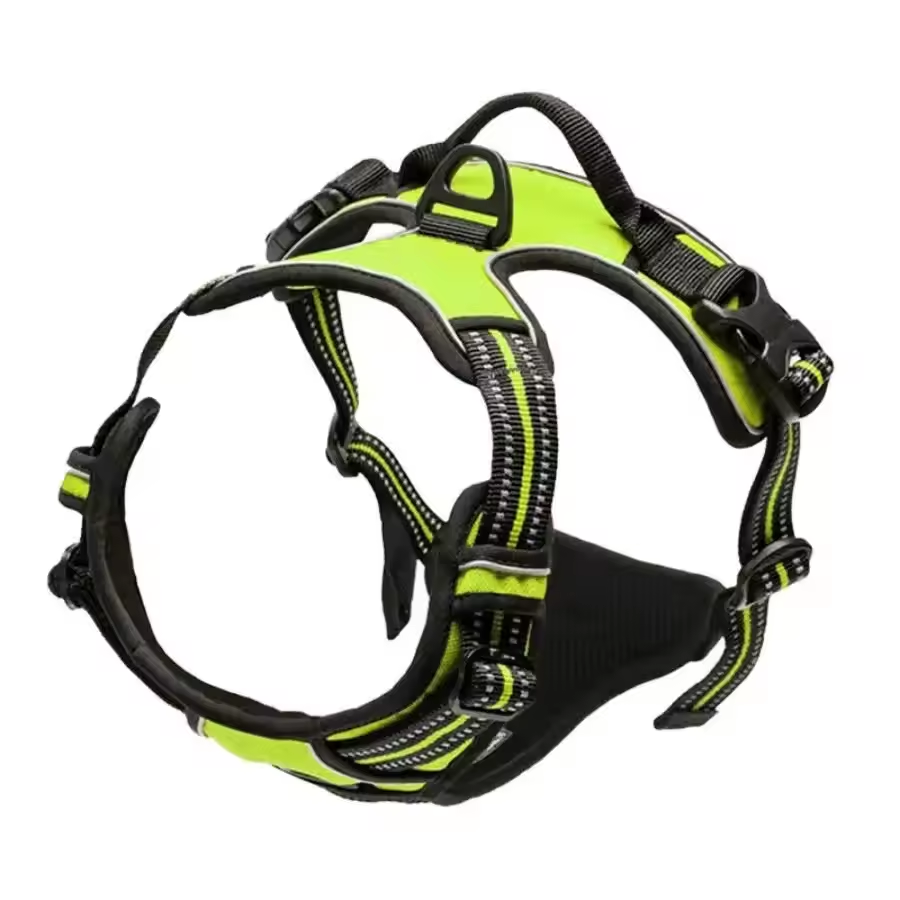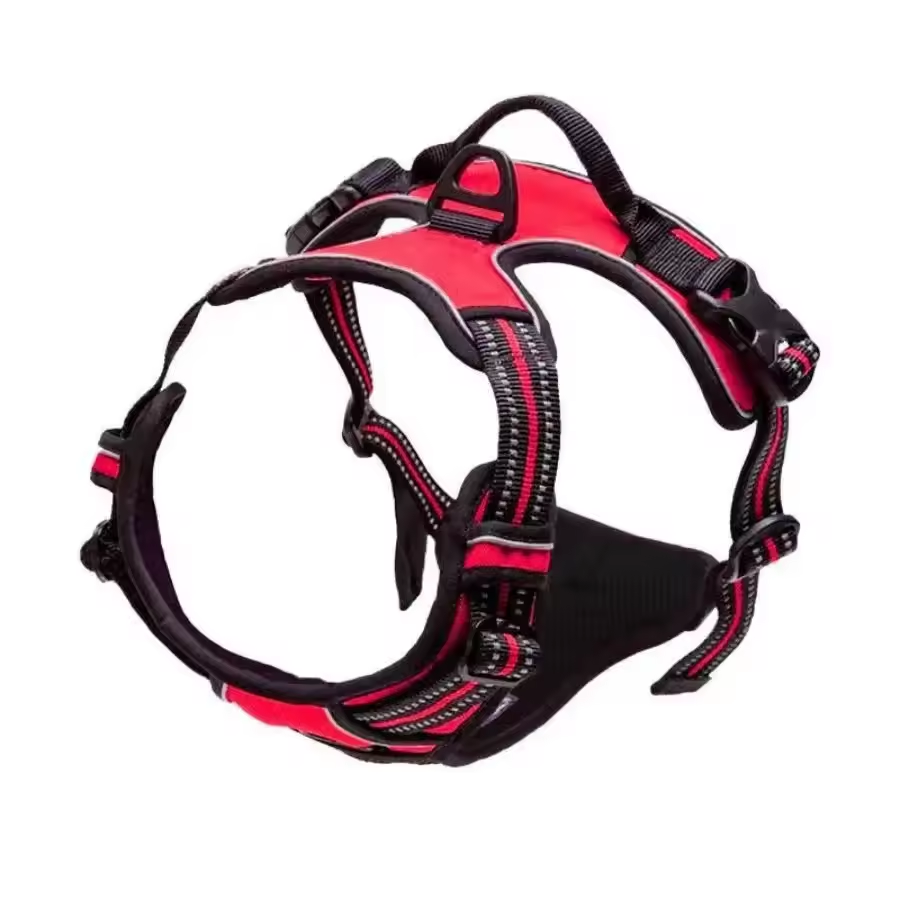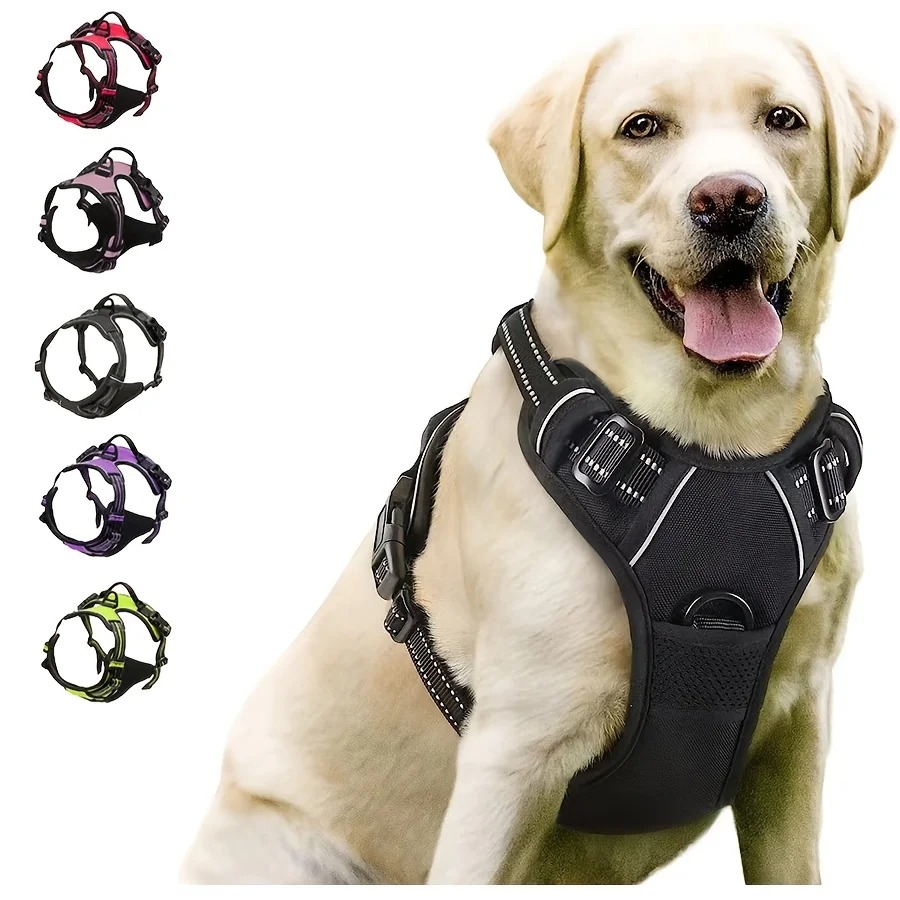Evaluating the Need for a Large Dog Harness
When you own a large breed, controlling them on walks is key. A large dog harness can offer better control and can help distribute pulling force. This makes walks easier for you and more comfortable for your dog.

Comfort and Control
A harness helps manage your dog’s movement without straining their neck or back. Look for a harness that provides chest and back support. It should also have adjustable straps to ensure a snug fit.
Breed and Behavior Considerations
Not all large dogs need the same type of harness. Some breeds might need more robust support due to their strength or temperament. Consider your dog’s breed, behavior, and activity level when choosing a harness.
Health and Age Factors
For dogs with health issues like arthritis, a harness can be a more compassionate choice than a collar. It’s also helpful for older dogs who require gentle handling due to their age.
Training and Safety
Using a harness can be an effective training aid for large dogs. It discourages pulling and can help teach better leash manners. It also increases visibility during walks, which is essential for safety.
Remember to regularly evaluate whether your large dog harness is meeting your pet’s needs. A well-fitted harness is a tool for a happier and healthier dog.
Key Features to Look for in a Large Dog Harness
Selecting the right large dog harness requires attention to specific features. Here’s what to focus on:
- Adjustability: Make sure the harness has adjustable straps. This ensures a snug and comfortable fit for your large dog.
- Durability: A robust harness that withstands pulling and wear is vital. Look for materials that can handle the strength of a large breed.
- Comfort: Padding is crucial for your dog’s comfort, particularly around the chest and shoulders. Choose a harness with ample cushioning.
- Easy to Use: You want a harness that’s simple to put on and take off. This makes your routine walks hassle-free.
- Reflective Elements: For safety during early morning or night walks, reflective stripes or patches are essential.
- Leash Attachment Points: A harness should offer both front and back leash attachment options for better control.
- Breathable Material: To prevent overheating, especially in warm climates, a harness made from breathable fabric is preferable.
These features enhance the walking experience for both you and your large dog. Aim for a balance of comfort, control, and safety when picking out a large dog harness.
Top Rated Harnesses for Large Dogs
When searching for the best large dog harness, certain brands and models stand out. These harnesses have earned top ratings for their quality, design, and user satisfaction. Let’s explore some of the top-rated options.
- Stronghold Sturdy Harness: It’s known for its durability and strength. Ideal for powerful breeds, this harness can manage the pull of even the most enthusiastic dogs.
- Comfort Padded Harness: This model comes with extra padding. It ensures your dog’s comfort during long walks. It also has an ergonomic design that fits snugly without chafing.
- EasyFit Quick Harness: For those who want convenience, this harness is a winner. It has a simple design that makes it easy to put on and take off. This is great for dogs who are fidgety during prep time.
- Reflective Safety Harness: Safety is critical, and this harness offers reflective strips. These strips increase your dog’s visibility in low light conditions.
- Breezy Mesh Harness: A top choice for hot climates, it’s made with breathable materials. It helps keep your dog cool even on the warmest days.
- Multi-Point Trainer Harness: With front and back attachment points, this harness aids in training. It helps reduce pulling and improves walking manners.
Each of these harnesses provides unique benefits tailored to the needs of large dogs. Consider your dog’s size, activity level, and your own handling preferences when choosing. Always look for harnesses that offer growth allowance, as large breeds may continue to expand in chest girth. Select a large dog harness that combines security, comfort, and control, to make your walks more enjoyable.

How to Measure Your Dog for the Right Harness Fit
Finding the right fit for a large dog harness is crucial. A harness that is too tight can be uncomfortable or restrict your dog’s movement. On the other hand, a harness that is too loose might not give you the control you need and could allow your dog to escape. To ensure the most accurate fit, follow these steps:
- Measure Your Dog’s Neck: Use a cloth tape measure to measure the circumference of your dog’s neck, where a collar would sit. Place two fingers under the tape measure to ensure that there is enough space for your dog to breathe and move comfortably.
- Measure the Widest Part of Your Dog’s Chest: The chest measurement is typically taken around the widest part of your dog’s rib cage, just behind the front legs. Again, remember to leave enough room for two fingers to slide under the tape measure for comfort.
- Consider Your Dog’s Weight: Weight can influence the harness size to choose, especially for large breeds. Although weight isn’t a measurement, it’s helpful to keep in mind for harnesses that have weight recommendations.
- Check the Manufacturer’s Size Chart: Each harness brand has its own size chart. Compare your dog’s measurements with the size chart to pick the most suitable harness.
- Account for Growth: If you have a growing puppy or a dog that is prone to weight changes, consider adjustable features on the harness. This allows for some growth or weight fluctuation without the need for a new harness.
- Test for Fit: Once you have a harness, test its fit. You should be able to fit two fingers under any strap. Your dog should be able to move freely, without the harness twisting or sliding.
It’s important to repeat the measurement process periodically, as dogs’ sizes can change due to growth, weight gain, or weight loss. Using these measurements, select a large dog harness that provides both comfort and control for your canine companion.
The Pros and Cons of Different Harness Materials
Choosing the right material for your large dog harness is as important as the fit. Different materials offer various advantages and drawbacks. Let’s weigh the pros and cons.
Nylon Harnesses
Pros:
- Nylon is strong and durable, making it suitable for energetic large dogs.
- It’s affordable and widely available in many styles and colors.
- Nylon dries quickly and is easy to clean, which is practical for active dogs.
Cons:
- It can sometimes chafe or irritate your dog’s skin, especially if not properly fitted.
- Nylon is not as breathable as some other materials, which might be a concern in hot weather.
Leather Harnesses
Pros:
- Leather offers a classic look and natural strength.
- It tends to be more comfortable over time as it molds to your dog’s body.
- With proper care, leather can last for years.
Cons:
- Leather requires regular maintenance to prevent cracking and retain its look.
- It’s generally more expensive than nylon and other synthetic materials.
- Leather is not as resistant to water and can take longer to dry.
Neoprene Harnesses
Pros:
- Neoprene is padded for added comfort and is good for dogs with sensitive skin.
- It’s a water-resistant material, ideal for dogs that love swimming.
Cons:
- Can be heavier, which might not be ideal for all large dogs.
- It can retain heat, making it less suitable for hot climates.
Mesh Harnesses
Pros:
- Mesh is lightweight and breathable, perfect for hot weather to keep your dog cool.
- It’s also soft, which minimizes the risk of chafing and irritation.
Cons:
- May not be as durable as other materials when faced with a strong pulling force.
- Not all mesh is created equal; some are prone to tearing or snagging.
When selecting a large dog harness, consider your environment, your dog’s activities, and any skin sensitivities they may have. Always balance the need for durability and strength with comfort and your dog’s well-being.

Training Your Dog to Wear a Harness
Teaching your large dog to wear a harness can seem daunting, but with patience and consistency, it can be a smooth process. Here’s how to guide your dog through the adjustment phase:
- Introduce the Harness Gradually: Let your dog sniff and examine the harness. Associate it with positive things like treats or playtime.
- Start with Short Sessions: Put the harness on for short periods of time at home. Give praise and treats to create a positive experience.
- Ensure Proper Fit: Before training starts, guarantee that the harness fits your dog comfortably. Adjust it as needed, ensuring you can fit two fingers under the straps.
- Secure the Harness Calmly: When fitting the harness on your dog, talk in a calm and soothing voice. This helps your dog stay relaxed.
- Practice Inside: Start by walking your dog around the house with the harness on. This allows your dog to adjust without too many distractions.
- Gradually Increase Duration: Slowly increase the time your dog wears the harness. This builds comfort and familiarity.
- Move Outdoors: Once your dog seems comfortable, start taking short walks outside. Keep sessions brief and positive at first.
- Stay Consistent: Try to put the harness on at the same time each day. Consistency helps your dog learn what to expect.
- Watch for Signs of Discomfort: Monitor your dog for any signs of distress or discomfort. Make adjustments to the harness or training method if needed.
Always remember to reward your dog generously throughout the process to reinforce their good behavior. With time and patience, your large dog will be comfortable and secure in their new harness, making your walks more enjoyable and safe.
Safety Tips for Walking Large Dogs with a Harness
Ensuring safety during walks with your large dog is of utmost importance. A large dog harness can enhance the security of your outings, but it’s crucial to follow certain safety tips. Here are some key measures to keep in mind when walking your large dog with a harness:
- Visibility is Vital: Choose a harness with reflective elements. This makes your dog more visible to drivers during early morning or evening walks.
- Pick the Right Leash: Use a sturdy leash that can handle your dog’s strength. Avoid retractable leashes as they may not provide sufficient control.
- Stay Alert: Keep your focus on your surroundings and your dog. Avoid distractions like using your phone or listening to loud music.
- Train for Good Leash Manners: Encourage your dog to walk without pulling. Use treats and praise to reward good behavior.
- Keep a Firm Grip: Hold the leash firmly. Wrapping it around your wrist can provide extra control if needed.
- Regular Harness Checks: Inspect the harness before every walk. Look for any signs of wear or damage that could weaken its effectiveness.
- Approach Others with Caution: Respect other pedestrians and animals. Keep a safe distance if your dog is not friendly with strangers or other dogs.
- Carry Identification: Ensure your dog has identification tags on their harness. This is crucial if they manage to slip away.
- Mind the Weather: In hot climates, walk your dog during cooler times of the day. In cold or wet conditions, consider a harness that can keep your dog warm and dry.
By following these safety tips, you can enjoy peaceful, enjoyable walks with your large dog while minimizing potential hazards. Remember, a secure harness and attentive practices are the foundation for safe, pleasant strolls with your canine companion.
Maintaining and Cleaning Your Dog’s Harness
A clean and well-maintained large dog harness is important for your dog’s comfort and safety. Over time, harnesses can collect dirt, fur, and wear out, affecting their function. Here are practical tips for maintaining and cleaning your dog’s harness.
- Regular Inspection: Check your harness regularly for signs of damage. Look for frayed edges, loose threads, or broken buckles. Early detection can prevent harness failure during walks.
- Brush Off Dirt: After each walk, remove loose dirt or mud. A simple brush can keep it tidy between washes.
- Hand Wash Gently: Hand wash the harness with mild soap and warm water. It’s gentler than machine washing and helps the harness last longer.
- Avoid Harsh Chemicals: Steer clear of strong detergents which can break down the harness material. They can also irritate your dog’s skin.
- Dry Properly: Never twist the harness to dry. Lay it flat in a well-ventilated area out of direct sunlight.
- Storing Correctly: When not in use, hang the harness up or store it in a cool, dry place to keep it in shape.
- Regular Replacement: No harness lasts forever. If it’s showing signs of serious wear or doesn’t fit well anymore, it’s time for a new one.
By keeping up with these maintenance steps, your large dog harness will stay in peak condition. This ensures every walk is safe and comfortable for both you and your large dog.